Up until a couple years ago, I had never been the one to introduce students to integer operations. I definitely have room for improvement when it comes to teaching integer stuff, but then again, when isn’t there room for improvement when it comes to this job? Below is a snapshot into our unit on integer operations.
Adding and Subtracting Integers
I’ve tried a couple different ways of introducing students to adding and subtracting integers. I’ve used Sarah’s “Sea of Zeros” and a number line to represent what is happening. This year, we focused more on number line rather than using the colored counters, and I’m not sure why, other than time. It seemed like every time we were going to use the colored counters, something else that day took longer, and I didn’t take the time to get them out.
Last year, I saw this Desmos activity, and loved it, but I didn’t use it for whatever reason. I did create one for multiplication and division based off of this activity that I used. This year, I used both activities. What I really like about these activities is that students practice noticing patterns, generalizing patterns, and applying those ideas to new problems -something we talk a lot about the first few days of school, and integers are the first unit with my seventh graders.

(Update 10/18: This year when I taught this, I spent a lot more time with the integer mats and got out the counting chips on multiple days and let students pick on other days whether or not they wanted to use them. I need to remember to make more time for this in the future. Some students really benefited from this. I overheard one student say, “I guess I am a hands on learner.” so I knew it was beneficial to take the time for these things. I also used the Desmos activity for subtracting integers, and thought it went well and plan on using it again in the future.
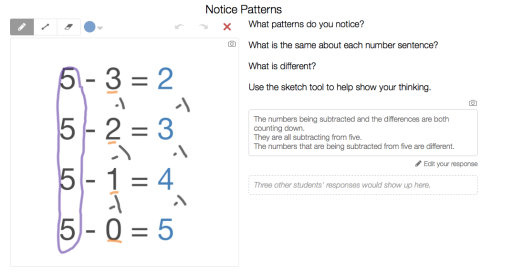
I also added this activity to practice adding integers. Students really enjoyed this.)

Multiplying and Dividing Integers
The Desmos activity I made to parallel the activity above is primarily what I use for multiplying and dividing integers. I wrote about that in this blog post.
After students work through that, we also have the conversation about the idea that negatives are opposites. If we’re trying to find -3(2) students know 3(2) is 6 and we want the opposite of that, or in the case of (-3)(-2), we find 3(2) and then want the opposite of that and then the opposite again.
Practice
Depending on the year I’ve done multiple different combinations of the following activities.
- Desmos Card Sort- I know that this is probably a pointless Desmos card sort, but Desmos had just come out with card sorts when I created it, and I wanted to try it out. Here is what I came up with.
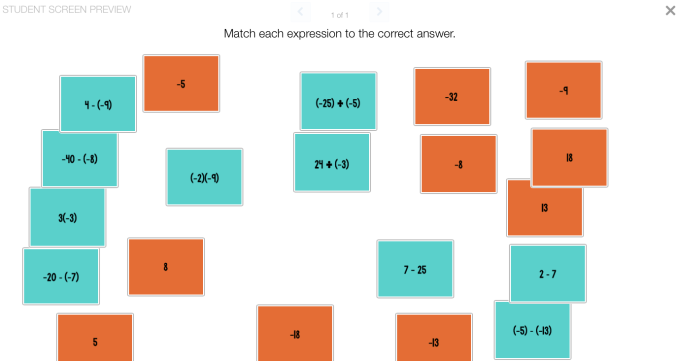
- Game- I don’t have a name for this game. I first learned about it when I was doing my student teaching for Spanish. Another Spanish teacher made one for vocab. The goal is to have the most cards at the end. To play students are put in groups of 3-4 and one person is the dealer. I suppose the dealer could rotate so that all students take turns doing the problems on the cards, but I have never done it that way. When it’s your turn, the dealer flips over the top card and you answer the question on the card. If you get it right, you get to keep the card and can choose to go again. As long as you keep getting questions correct, you can keep getting new cards. At any point in your turn, you can choose to be done and then you are guaranteed that you will get to keep the cards you answered correctly for that round. If you answer a question wrong, you lose all the cards you had answered correctly in that round.
As an added twist to the game, there are several cards that have either a smiley face or a
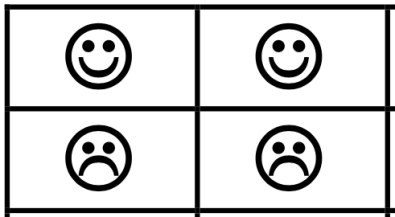
frowny face on them. If a student gets a smiley face, they get to keep
all the cards they had won up to that point in that round; they can’t lose them. If a student gets a frowny face, they
lose all their cards from that round.
If students disagree on an answer, I will either check it, or I will have them check it with a calculator. (The link to download this is at the end of the post.)
- I Have…Who Has… I found a couple of these games for free on Teachers Pay Teachers. I learned the hard way that I like the cards where the question is something like “Who has 12(-3)?” because students end up doing more problems than if the question was “Who has -36?” Two of the ones I have found are here and here.
Order of Operations
After doing some practice with integer operations, we start doing order of operations with integers.
- Warm-ups: One of my favorite warm-ups when we are doing order of operations is “Find the Flub”. I love that it forces students to think through an already worked out problem to find the mistake.
- Witzzle- I first heard about Witzzle from Sarah’s blog. You can read more about it in her posts. Essentially, students need to use the three numbers in any row, column, or diagonal to make the target number. The target number can be anywhere from -12 to 36. I tried this game for a warm-up for the first time this year, and I really liked how it went. I can see myself using this more often.

- One Incorrect Worksheet- I blogged about these here. My students sometimes get frustrated with these worksheets, but I see that as a good thing. They get frustrated because the worksheet forces them to go back and fix their mistakes when they get something other than -13 for the answer to more than one problem. (You can download this at the end of the post.)
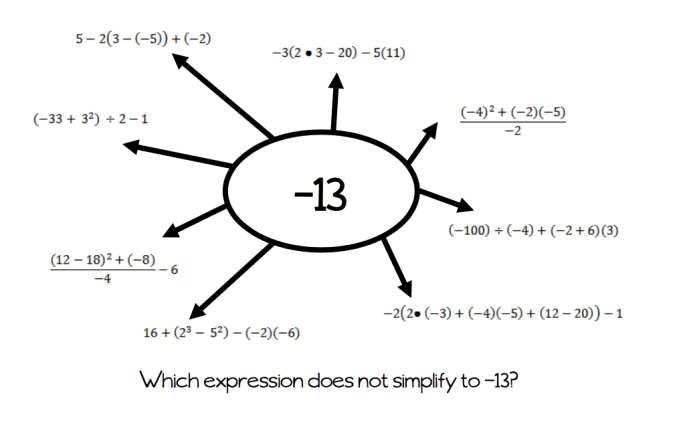
- Add ‘Em Up- Sara Van Der Werf first introduced me to this activity. You can read her post here. I created one for integer operations that you can download in the link at the end of the post.
- Review- I wanted the review that students did to be self-checking, so I modified Sara’s Add ‘Em Up activity and made it into a worksheet. There are two different types on the worksheet. The first is simply integer operations.
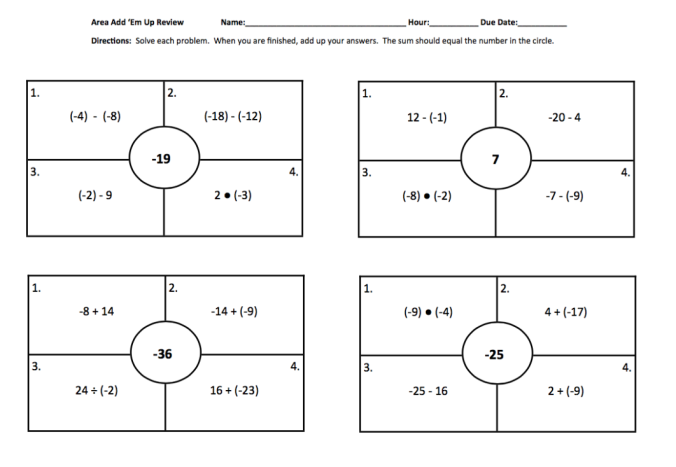
The second is order of operations with integers as well as some problems including absolute value.

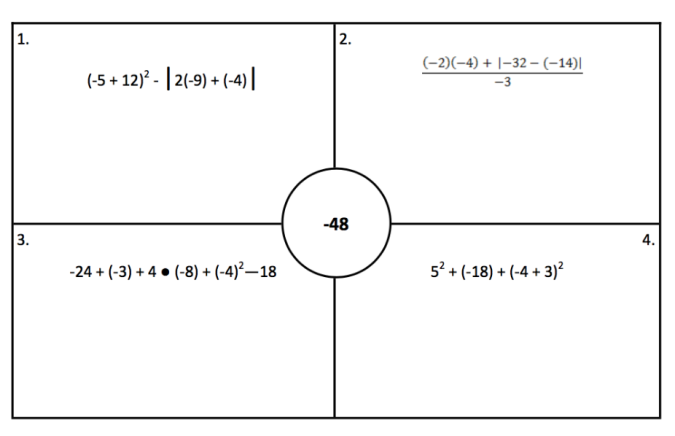
(Update 10/18: I also added this sometimes, always, never activity towards the end of the unit as a review. This was the first time I had done a sometimes, always, never activity, but I was encouraged to try it after attending Chris and Mattie’s session at TMC18. I wanted to get my students talking and debating about integers. This activity worked great for that.)
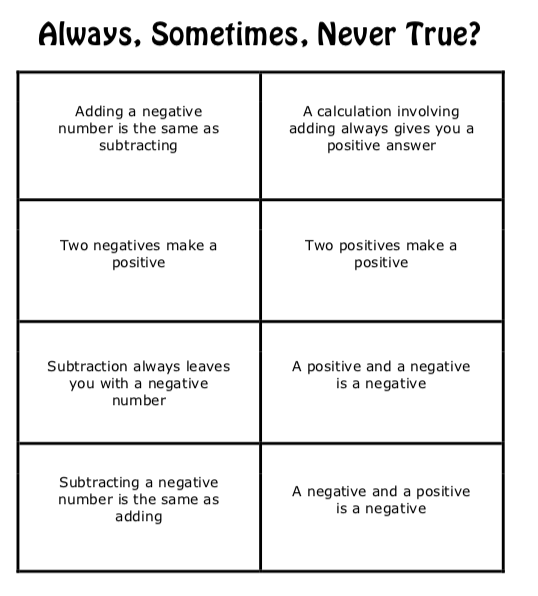



These look awesome!! I could not get them to download – it said they may be protected. Is there a trick to it?
LikeLike
Hmm…I’m not sure what to tell you. I had someone else try and was told they were able to download the files. If you were at school, could it be something with your school’s server?
LikeLike
Thank you so much. I am doing integers operations with my 7th graders and this was extremely helpful.
LikeLike